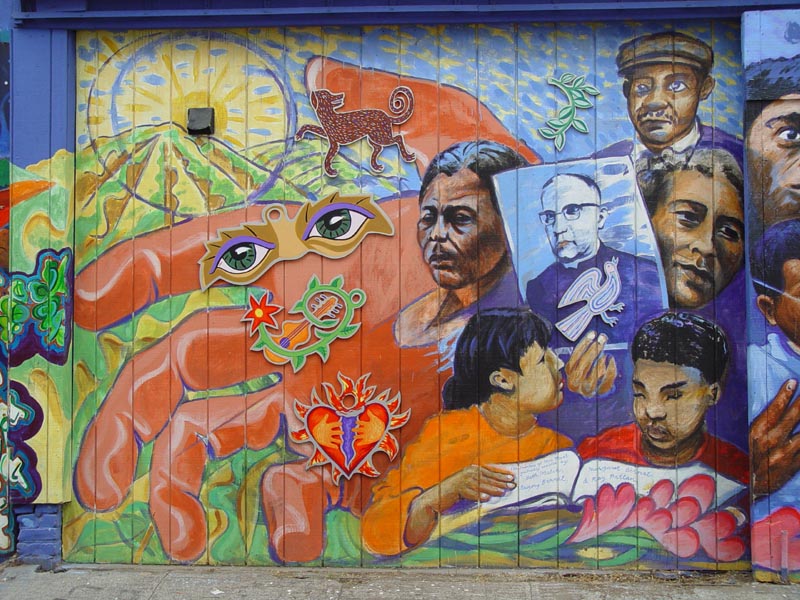
A mural in San Francisco dedicated to Archbishop Oscar Romero, an advocate for the poor. (Livenature / Flickr)
We are now in the midst of Holy Week, that time every Spring when Christians commemorate the last days and nights of Jesus; from his triumphant procession through Jerusalem on Palm Sunday, through his crucifixion on Good Friday, and to his resurrection on Easter Sunday. This year offers the anticipation of the path to sainthood for one of Latin America’s most significant Roman Catholics of the latter twentieth century, Salvadoran Archbishop Óscar Romero. Romero’s life, death, and message of liberation serves as a symbol beyond that of Central American Catholics, reaching all who are poor, oppressed, and crying out for justice. The brand of Catholicism Romero preached, lived out, and died for is known as “liberation theology,” a path that offers hope to the least fortunate and compels those with means to struggle on their behalf. That Pope Francis has provided outward acknowledgment of Romero’s martyrdom is a great leap forward for the legitimacy of liberation theology within greater Catholicism—providing further encouragement for Catholicism to reconnect with its social justice advocacy while paving a path for Romero’s beatification toward sainthood.
Liberation theology was birthed in Medellín, Colombia in response to the 1960’s Second Vatican Council (also known as Vatican II), which sought, among other things, to renew the Church and start a dialogue with the contemporary world. In a new way, this theology responds and engaged with the world by actively and boldly preaching God’s preferential option for the poor—that God is always on the side of the destitute, downtrodden, and oppressed. Throughout the Bible, we see God acting on behalf of the marginalized and exploited; elements that are especially present throughout New Testament depictions of Christ’s ministry and teachings, as he himself was a poor Jewish carpenter oppressed and executed by the imperial state of Rome. Liberation theology serves as a biblical, faithful, and loving response to the oppressive, faceless, and structural powers that seek to perpetuate not only socio-economic inequity, but also more importantly, the brutal dehumanization of God’s creation in God’s image. That is, humanity.
Believing in Jesus and going to church is not enough to live in the model of Christ; there must be real and lasting action, praxis, as well. To truly be Christ-like, Christians must do something about the sin and injustice in their midst. Singing praise songs won’t cut it. This requires working faithfully for real and lasting change with, and for, the impoverished in order to improve their living circumstances. There must also be a real and sustained effort to transform the underlying institutional structures that prevent all God’s people from flourishing and from living in peace and safety. This means that there must not only be socio-economic change, but political change as well.
It is not surprising, then, that liberation theology has been criticized as Marxist. Both Christianity and Marxism make plain and call to task the realities of social disparity and incorporate tenets for real and lasting change for the benefit of the oppressed and the humbling of the rich and powerful. It is naïve, however, to equate the millennia-old message of Christian liberation with classical Marxist doctrines on social transformation. Yet, in the 1980s, this is exactly what happened. Fearful of the Soviet brand of atheist Marxism, Popes John Paul II and Benedict XVI (then known as Cardinal Ratzinger) suppressed the voices of liberation theology in Latin America, believing it was unorthodox and harmful to the faith. Their efforts did not prevent liberation theology from beginning to take root in the hearts and minds of Christians throughout the world, in part because of the actions and sacrifice of Archbishop Óscar Romero.
Romero’s Legacy
When appointed archbishop in 1977, both socially-progressive priests and the nation’s leadership expected the conservative and traditionalist Romero to toe the line of ecclesiastic power among the Salvadoran elite, thinking he would dismiss the liberation theology that only a few years old. However, he surprised everyone, quickly becoming an advocate for the poor. Romero almost immediately began to respond to El Salvador’s ruling military junta—a regime which systematically murdered, abused, and executed political detractors and challengers to its power. In the name of God, he called on the soldiers to stop the repression.
It was standard Cold War practice for the United States and Soviet Union to fight indirectly, arming alarming numbers of nations to fight what amounted to civil wars on behalf of the lazy virtues of capitalism and communism. The real losers in all of this were these countries’ populations, which often suffered from shattered national infrastructure, the loss of tens of thousands of lives, and the indifference—if not the complete ignorance—of the general populations of the U.S. and Russia.
While higher-profile conflicts were fought in Southeast and Central Asia, Central and South America were rife with internecine conflict infused with the finest NATO and Warsaw Pact materiel money could buy. El Salvador was one of many Central American countries where Western-backed governments fought against populist rebels to prevent a “domino effect” of communist victory at the back door of the United States. These brutal dictatorships ruled with such impunity that they regularly tortured and murdered their own citizens, hoarded national wealth, and openly flouted the democracy and freedom they allegedly defended.
Thirty-five years later, Pope Francis officially proclaimed the archbishop to be a martyr, having died directly as a result of his faith. Francis is the first Latin American ever elected as pope, signifying a radical shift from the European dominance of Catholic power and authority, as well as the Catholic population shift from the industrialized north to the global south. Francis, an Argentinian Jesuit immersed and educated in liberation theology, provides a fresh perspective on colonialism, power, and the role of the Church in the world. Romero is one of his own.
While the word “martyr” is often used pejoratively in our culture, the word has a very specific theological designation for Christians who have suffered persecution for their faith. The word is derived from ancient Greek, the language of the New Testament, meaning “witness.” In the teachings of the Roman Catholic Church, known as the Catechism, martyrdom “is the supreme witness given to the truth of the faith: it means bearing witness even unto death. The martyr bears witness to Christ who died and rose, to whom he is united by charity. He bears witness to the truth of the faith and of Christian doctrine. He endures death through an act of fortitude.” While there have been—and continue to be—countless martyrs in the Christian faith over the last two thousand years, there has been an official, slow, and tedious process toward sainthood since the thirteenth century. If the candidate makes it through this gauntlet unscathed, then he or she is considered “beatified,” and most likely in heaven. Once beatification takes place, the person can finally be canonized and achieve sainthood. No one ever said becoming a saint was easy.
Though Romero made the cut back in 1997 when he was officially designated as a “Servant of God” by Pope John Paul II, Romero’s path to sainthood stalled—placing him in a veritable limbo for the past two decades. That is, until this past February when Pope Francis officially unblocked him, recommending Romero be fast-tracked for a halo.
Present-day Politics meets Latin-American Catholicism
Latin Americans immigrate to the United States come with countless stories of government corruption, abject poverty, and drug cartel violence. Honduras now leads the world in the rate of homicides. Democratically elected governments are now more stable throughout Central and South America, but at what cost? Though considered “dead” and unnecessary in the 1990’s with the fall of communism and the triumph of democracy and freedom, the message of—and need for—liberation theology is as relevant now as when it was born fifty years ago.
With the increased migration of Latin American Catholics into the United States, there is a real and lasting opportunity to affect and change not only American Catholic culture, but American culture in general. Living in Carroll Gardens, I am keenly aware of the deep working-class Italian roots of this neighborhood, even as it resists gentrification. Italian Catholicism and her saints are ever-present, especially during Holy Week. With Latin Catholicism now entering the American melting pot in new ways and with new force, there is the opportunity for new saints and new traditions.
Saints embody the needs of the people and direct them toward their God and their salvation. It’s no wonder that saints remain popular. One in five New Yorkers live below the federal poverty threshold. The US Census Bureau found last year that in Manhattan, “the top five percent of households earned $864,394, or 88 times as much as the poorest 20 percent,” as reported by the New York Times.
So, what could a Saint Óscar Romero mean for us, then, as New Yorkers, even for those of us who are neither Latino, nor Catholic? It can mean that liberation theology, once marginalized and treated as a fad, is now brought into the United States by those who have experienced it firsthand. It can mean that we can experience a spirit of justice by working toward it for all people. The Gospel proclaimed in liberation theology has the opportunity to affect real socio-political change, both personal and structural, to better the lives of all New Yorkers and Americans. We only have to embrace it.
Where Irish, Polish, and Italian Catholics have, in turn, created great change in the United States, now the cultural and theological tapestry of Latino theology, liberation theology, can begin to take shape in the United States, especially as socio-economic and political power increasingly is found in the hands of an elite one percent and an ever-growing Latino minority finds employment in the service and labor industries, much like their immigrant Catholic brethren before.
With the inspiration and icon of Saint Romero, there can be a new saint in the United States that reminds us, Catholic and non-Catholic, Christian and non-Christian, that there is something more than the tyranny of wealth and poverty. Romero reaffirms that every life has dignity and value, and that there is something more to each of us than merely a nameless statistic, a job that pays the bills, and an anonymous person on the street and subway. Even if we do not believe that there is a God who is always on the side of the poor, we can choose to be on the side of the poor, to look to Romero as their advocate and our own, and to act in real ways to ensure each of us remains human in the midst of a very cold and impersonal city.
An assassin’s bullet failed to silence the voice of Óscar Romero. With his expected canonization, there is a new saint for not only the poor and the oppressed but also a saint for all of us who seek justice, equality, and dignity. Romero can be a new saint of and for the New World and New York, even as there is still work to do to free the world from the sin of injustice.
·
Burke Gerstenschlager lives in Carroll Gardens and writes at bleaktheology.com.

